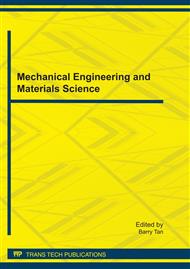[1]
S. Liu, N. Tian, Z. Liu, J. Huang, J. Li and J. F.S. Ferreira. Affordable and sensitive determination of artemisinin in Artemisia annua L. by gas chromatography with electron-capture detection. Journal of Chromatography A. 2008 (1190): 302–306.
DOI: 10.1016/j.chroma.2008.02.089
Google Scholar
[2]
S. Aquil, A. Husaini, M. Abdin and G. Rather. Overexpression of the HMG-CoA reductase gene leads to enhanced artemisinin biosynthesis in transgenic Artemisia annua plants. Planta Med. 2009, 75(13): 1453-8.
DOI: 10.1055/s-0029-1185775
Google Scholar
[3]
M. Auldridge, A. Block, J. Vogel, C. Dabney-Smith and I. Mila,. Characterization of three members of the Arabidopsis carotenoid cleavage dioxygenase family demonstrates the divergent roles of this multifunctional enzyme family. Plant J. 2006, 45: 982–993.
DOI: 10.1111/j.1365-313x.2006.02666.x
Google Scholar
[4]
F. Bouvier, C. Suire, J. Mutterer and B. Camara. Oxidative remodeling of chromoplast carotenoids: identiWcation of the carotenoid dioxygenase CsCCD and CsZCD genes involved in Crocus secondary metabolite biogenesis. 2003, Plant Cell 15: 47–62.
DOI: 10.1105/tpc.006536
Google Scholar
[5]
A.J. Simkin, S.H. Schwartz, M. Auldridge, M.G. Taylor and M.G. Klee. The tomato carotenoid cleavage dioxygenase 1 genes contribute to the formation of the flavor volatiles β-ionone, pseudoionone, and geranylacetone. Plant J. 2004, 40: 882–892.
DOI: 10.1111/j.1365-313x.2004.02263.x
Google Scholar
[6]
A.J. Simkin, B.A. Underwood, M. Auldridge, H.M. Loucas, K. Shibuya, E. Schmelz, D.G. Clark and H.J. Klee. Circadian regulation of the PhCCD1 carotenoid cleavage dioxygenase controls emission of β-ionone, a fragrance volatile of petunia flowers. Plant Physiol. 2004, 136: 3504–3514.
DOI: 10.1104/pp.104.049718
Google Scholar
[7]
Z. Sun, J. Hans, M. Walter and R. Matusova. Cloning and characterisation of a maize carotenoid cleavage dioxygenase (ZmCCD1) and its involvement in the biosynthesis of apocarotenoids with various roles in mutualistic and parasitic interactions. Planta. 2008, 228: 789–801.
DOI: 10.1007/s00425-008-0781-6
Google Scholar
[8]
R. Matusova, K. Rani, F.W. Verstappen, M.C. Franssen, M.H. Beale and H.J. Bouwmeester. The strigolactone germination stimulants of the plant–parasitic Striga and Orobanche spp. are derived from the carotenoid pathway. Plant Physiol. 2005, 139: 920–934.
DOI: 10.1104/pp.105.061382
Google Scholar
[9]
M. Ibdah, Y. Azulay, V. Portnoy, B. Wasserman, E. Bar, A . Meir, Y. Burger, J. Hirschberg, A.A. SchaVer, N. Katzir, Y. Tadmor and E. Lewinsohn. Functional characterization of CmCCD1, a carotenoid cleavage dioxygenase from melon. Phytochemistry. 2006. 67: 1579–1589.
DOI: 10.1016/j.phytochem.2006.02.009
Google Scholar
[10]
A.J. Simkin, S.H. Schwartz, M. Auldridge, M.G. Taylor and H. J. Klee. The tomato carotenoid cleavage dioxygenase 1 genes contribute to the formation of the flavor volatiles β-ionone, pseudoionone, and geranylacetone. The Plant Journal. 2004, (40): 882–892.
DOI: 10.1111/j.1365-313x.2004.02263.x
Google Scholar
[11]
S. Liu, N. Tian, J. Li, J. Huang and Z. Liu. Isolation and identification of novel genes involved in artemisinin production from flowers of Artemisia annua using suppression subtractive hybridization and metabolite analysis. Planta Med. 2009 . 75(14): 1542-7.
DOI: 10.1055/s-0029-1185809
Google Scholar
[12]
F. Cunningham, Z. Sun, D. Chamovitz, J. Hirschberg and E. Gantt. Molecular structure and enzymatic function of lycopene cyclase from the cyanobacterium Synechococcus sp. Strain PCC7942. Plant Cell, 1994, 6, 1107–1121.
DOI: 10.1105/tpc.6.8.1107
Google Scholar
[13]
F. Cunningham, B. Pogson, Z. Sun, K.A. McDonald, D. DellaPenna, E. Gantt. Functional analysis of the α- and β-lycopene cyclase enzymes of Arabidopsis reveals a mechanism for control of cyclic carotenoid formation. Plant Cell, 1996, 8: 1613–1626.
DOI: 10.1105/tpc.8.9.1613
Google Scholar
[14]
Z.R. Sun, E. Gantt and F. Cunningham. Cloning and functional analysis of the b-carotene hydroxylase of Arabidopsis thaliana. J. Biol. Chem. 1996. 271, 24349–24352.
DOI: 10.1074/jbc.271.40.24349
Google Scholar
[15]
J. Gershenzon and N. Dudareva. The function of terpene natural products in the natural world. Nature Chemical Biology 3, 2007. 408-414.
DOI: 10.1038/nchembio.2007.5
Google Scholar


